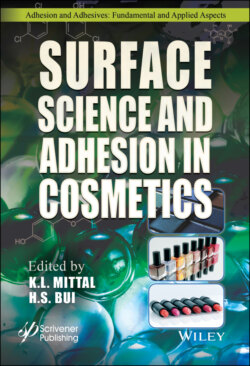Читать книгу Surface Science and Adhesion in Cosmetics - Группа авторов - Страница 53
2.5.3 Factors Affecting Lipstick Structure: Wax Amount
ОглавлениеAs seen in Figure 2.20, by increasing the amount of wax from 15% to 25% in low viscosity HPIB oil (ɳ=14.8 mPa.s), the hardness of the lipstick is double from 150 grams to 300 grams. On increasing wax amount, the oil content reduces and viscosity of wax-oil system increases. Under cooling process from the melt, the wax-oil solution with high amount of wax would crystallize first and more crystals are formed. The DSC thermograms show that the crystallization and melting peaks increase and become broader with an increase of wax amount (Figure 2.21). The melting temperature Tm of PE wax crystals increases linearly with wax content, enhancing the hardness of lipstick structure as shown in Figure 2.22. The same behavior was observed in the sunflower wax – soybean system, candelilla wax-safflower oil and rice bran wax-salad oil, for which an increase of wax concentration increases both the gelling and melting temperatures and firmness of oil-wax gels [29, 36, 38].
Figure 2.19 SEM micrographs of PE wax-oil lipsticks at fixed 15% PE wax in ester oils with different oil viscosities (a) Isononyl isononanoate (ɳ = 9 mPa.s), (b) Neopentyl glycol dicaprate (ɳ = 19 mPa.s), (c) Polyglyceryl-2 tri-isostearate (ɳ = 290 mPa.s), (d) Diisostearyl malate (ɳ = 1,860 mPa.s) and (e) Polyglyceryl-2 tri-isostearate (ɳ = 24,200 mPa.s).
Figure 2.20 Effect of PE wax amount on hardness of the HPIB-wax system (HPIB viscosity = 14.8 mPa.s).
From the previous data, the hardness of the lipstick is influenced by the viscosity and the polarity of oil at a fixed amount of PE wax. Therefore, we can control the desired hardness of the lipstick by modulating the amount of PE wax in the selected viscosity oil for the lipstick. For example, with the HPIB oil blends, in order to obtain the lipstick hardness value of 135 grams, less amount of PE wax should be used in high viscosity oils. As shown below, 19% PE wax is used in a low viscosity HPIB (ɳ =15 mPa.s) and 9% PE wax is used in a high viscosity HPIB (ɳ = 9.2x103 mPa.s) to achieve the same hardness. Similarly, in case of polar ester oils, 17.9% and 9% PE wax are used in low viscosity (ɳ = 9 mPa.s) and high viscosity (ɳ = 1.86x103 mPa.s) ester oils, respectively to achieve the lipstick hardness of 140-143 grams. Figure 2.23 shows the lipstick hardness in polar oils and non-polar HPIB oil with various viscosities as a function of PE wax amount.
Table 2.7 compares the hardness and structure of PE wax crystallized in the HPIB oils at various viscosities. The low and high viscosity oil blends at 1/1 and 1/3 ratios are shown. It is observed that the structure of wax crystals does not change much with amount of wax in oil, and the lipstick hardness is strongly dependent on oil viscosity.
At highest oil viscosity (8.9x104 mPa.s), the wax crystals are smaller at 8% wax than at 15% wax, but the lipstick structure is softer due to lower crystal density. Similarly, 10% PE wax in the blend at 1 to 1 ratio of low and high viscosity HPIB has smaller crystal size and is closer-packed than 15% PE wax in the same oil blend. However, it is observed clearly that when wax increases from 8% to 19% and viscosity reduces from highest to lowest, the crystal size increases but the hardness of lipsticks does not vary much as seen in Table 2.7.
Figure 2.21 Effect of PE wax amount on the (a) cooling and (b) heating curves of PE wax in hydrogenated polyisobutene oil (ɳ =14.8 mPa.s).
Figure 2.22 Effect of PE wax amount on the melting temperature Tm in HPIB oil with viscosity = 14.8 mPa.s.
Figure 2.23 Effect of PE wax amount in selective viscosity oils on the hardness of lipsticks.
Table 2.8 shows the hardness and PE wax structure in selected ester oils with a range of viscosity and polarity. The structure of PE wax crystals does not change much when wax is reduced, except that the crystals become smaller and have more contact points when increasing wax from 15% to 17.5% in isononyl isononanoate (ɳ = 9 mPa.s). In polar oils, increasing wax amount increases the contact points of crystals and hardness of lipstick as observed from SEM views in Table 2.8.
Therefore, the lipstick structure can be controlled to a desired hardness by modulating the wax amount such that high amount of wax should be used in low viscosity oil and low amount of wax can be used in high viscosity oils. This crystallization behavior offers the opportunity to achieve a harder lipstick structure with a low amount of wax.
Table 2.7 Effect of wax amount on lipstick hardness and structure in selected non-polar oils and oil blends.
